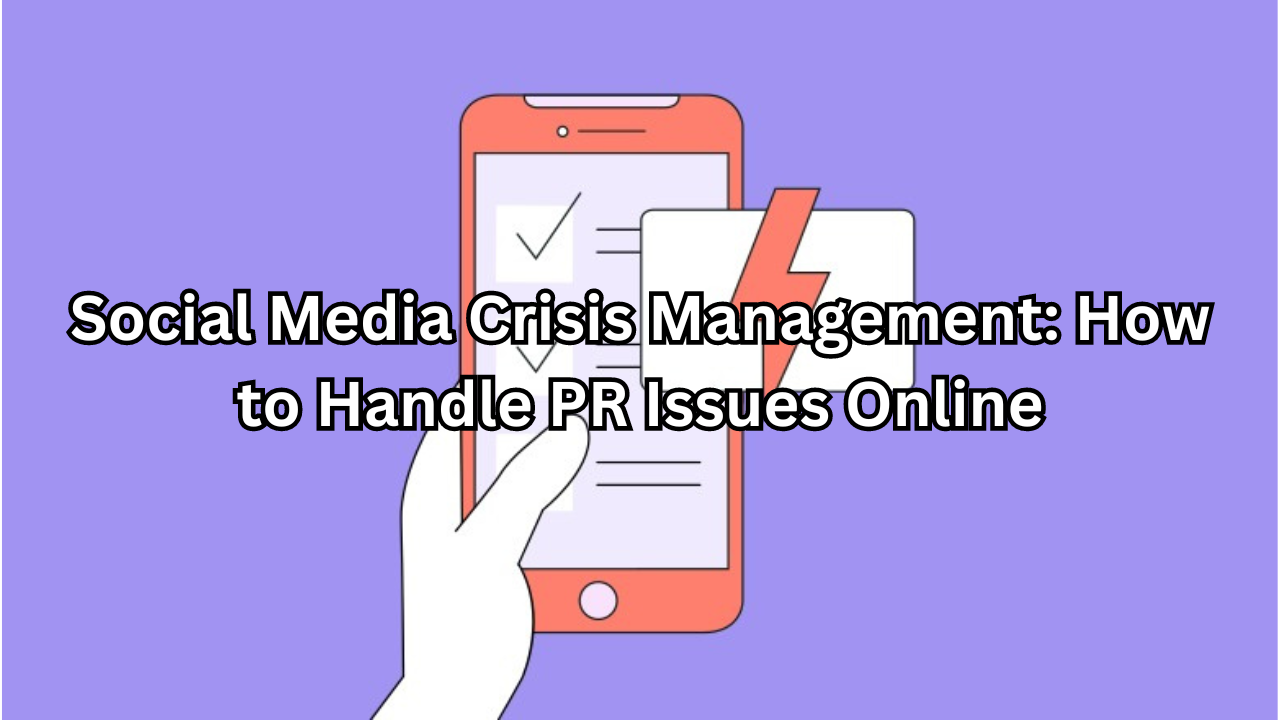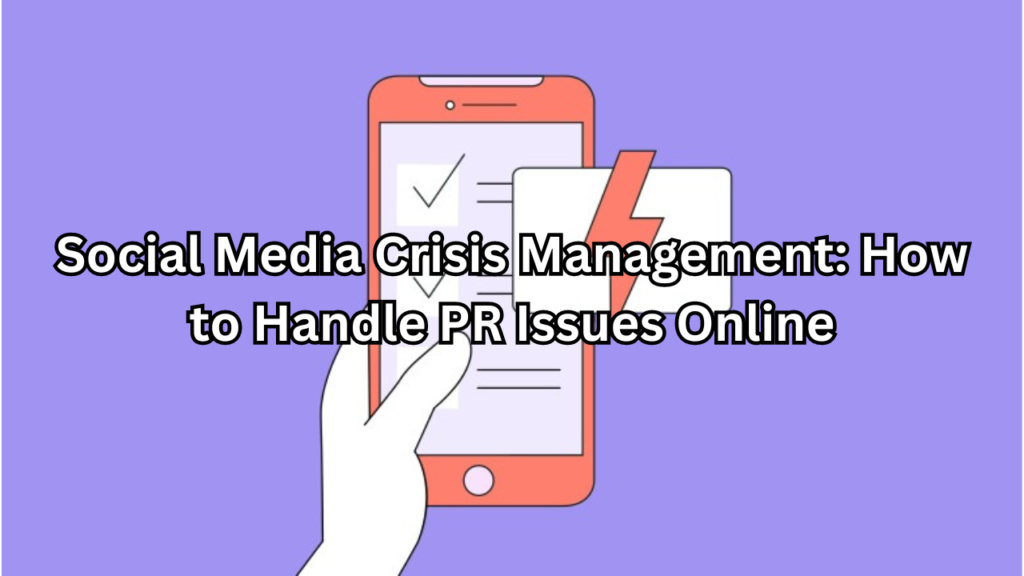

Table of Contents
Introduction
Social Media Crisis Management, social media is a double-edged sword for businesses and organizations. While it offers unparalleled opportunities for engagement and brand building, it also exposes companies to the risk of social media crises that can swiftly escalate and damage reputations. A social media crisis can arise from various issues, including negative customer feedback, controversial statements, or operational mishaps, and can significantly impact a company’s public image and bottom line. Effective crisis management is crucial for mitigating these risks and safeguarding your brand’s reputation. This article will guide you through understanding social media crises, the importance of managing them effectively, and practical strategies for addressing and recovering from such challenges.
Definition Social Media Crisis Management of a Social Media Crisis
A social media crisis is an event or situation that triggers a rapid and often uncontrollable surge of negative attention on social media platforms, which can severely damage a brand’s reputation. This could stem from a range of issues, including but not limited to, public relations blunders, customer service failures, controversial statements or actions by company representatives, or product recalls. The defining characteristic of a social media crisis is its potential to spread quickly across networks, amplifying the negative impact and complicating efforts to manage the situation.
Importance of Effective Crisis Management
Effective crisis management is essential for minimizing damage and restoring a brand’s reputation in the aftermath of a social media crisis. Without a well-thought-out strategy, companies risk escalating the issue, alienating their audience, and suffering long-term reputational harm. Proper management involves timely and transparent communication, strategic response planning, and proactive engagement with affected stakeholders. By addressing the crisis effectively, organizations can not only mitigate immediate damage but also rebuild trust and demonstrate resilience, turning a potentially damaging situation into an opportunity for growth and learning.
Overview of the Article’s Structure
This article will explore the critical components of managing a social media crisis, offering actionable insights and strategies. We will begin by defining the nature of social media crises and their potential impact. Next, we will discuss the importance of having a crisis management plan in place and outline the key elements of effective response strategies. The article will then delve into immediate actions to take when a crisis arises, how to manage the situation in real-time, and steps for post-crisis recovery. Finally, we will cover how to learn from the experience to improve future crisis management efforts. By the end of this article, you will have a comprehensive understanding of how to navigate and mitigate social media crises, ensuring your brand remains resilient and responsive in the face of adversity.
Recognizing a Social Media Crisis
Recognizing a social media crisis early is crucial for effective management and mitigation. A social media crisis often begins with subtle signs that can quickly escalate if not addressed promptly. Identifying these indicators can help you respond before the situation worsens, preserving your brand’s reputation and minimizing damage.
Indicators of a Potential Crisis
Sudden Surge in Negative Mentions: An unusual spike in negative comments, reviews, or mentions across social media platforms is a strong indicator of a brewing crisis. This can be triggered by customer complaints, controversial posts, or public backlash.
Increased Media Attention: When mainstream media picks up on a negative story originating from social media, it signals that the issue has gained significant traction and could potentially escalate further.
Engagement from Influencers: If prominent influencers or industry leaders are commenting negatively or sharing the issue, it can amplify the crisis and increase its visibility.
Viral Content: Content related to the crisis going viral indicates that the issue has captured widespread attention, which can accelerate its impact and spread.
Examples of Common Social Media Crises
Product Recalls: A well-known example is the 2015 Volkswagen emissions scandal, where negative social media buzz over vehicle emissions tests led to a significant PR crisis and lasting damage to the brand’s reputation.
Controversial Statements: In 2018, a tweet by a public figure resulted in a social media backlash that rapidly spread, highlighting how individual actions can provoke widespread criticism and lead to a crisis.
Customer Service Failures: The United Airlines incident in 2017, where a passenger was forcibly removed from a flight, led to a massive outcry on social media and exemplifies how poor handling of customer service issues can escalate into a full-blown crisis.
Missteps by Company Representatives: When a company spokesperson makes an insensitive or controversial remark, it can trigger a social media crisis, as seen in various high-profile incidents involving celebrities and executives.
The Role of Monitoring Tools and Social Listening
To effectively recognize and manage a social media crisis, leveraging monitoring tools and social listening is essential. These tools help in tracking online conversations and detecting potential issues before they escalate.
Monitoring Tools: Tools like Google Alerts, Hootsuite, and Brandwatch can provide real-time updates on mentions and keywords associated with your brand. These tools help in identifying early signs of a crisis and assessing the volume and sentiment of online discussions.
Social Listening: Social listening involves analyzing social media data to understand public sentiment and emerging trends. Platforms like Sprout Social and Mention allow you to track conversations, identify potential issues, and gauge the overall sentiment towards your brand.
Sentiment Analysis: By analyzing the tone and sentiment of online mentions, you can differentiate between minor concerns and serious issues that may require immediate attention. This helps prioritize responses and allocate resources effectively.
Alerts and Notifications: Setting up alerts for specific keywords or phrases related to your brand can ensure that you are immediately informed of any negative developments, allowing for a swift response.
By actively monitoring social media and employing social listening strategies, you can gain valuable insights into potential crises and take proactive steps to address them before they escalate. This preparedness is key to maintaining your brand’s reputation and ensuring effective crisis management.
Immediate Response Strategy
An effective immediate response strategy is crucial for containing a social media crisis and digital marketing. The actions you take right after identifying a crisis can significantly influence its outcome and your brand’s reputation.
Steps to Take Immediately After Identifying a Crisis
Assess the Situation: Quickly evaluate the severity and scope of the crisis. Determine what has happened, the potential impact, and the parties involved. This assessment will guide your response strategy and help prioritize actions.
Activate the Crisis Management Team: Mobilize your pre-designated crisis management team. This team should include key personnel from PR, social media, legal, and customer service departments. Their role is to coordinate the response and ensure a unified approach.
Gather Facts and Verify Information: Ensure you have accurate and complete information about the issue before making any public statements. Inaccurate or incomplete information can lead to misinformation and further complications.
Develop Initial Messaging: Craft an initial response that acknowledges the issue, provides necessary context, and outlines the steps your organization is taking to address it. Ensure that your messaging is consistent across all platforms.
Monitor and Adjust: Continuously monitor social media channels and news coverage to gauge public reaction and adjust your response strategy as needed. Be prepared to update your messaging based on new developments or feedback.
The Importance of Quick and Transparent Communication
Timely and transparent communication is essential during a social media crisis. Here’s why it matters:
Builds Trust: Quick responses show that you are taking the issue seriously and are committed to addressing it. Transparency helps build trust with your audience by providing clear and honest information.
Prevents Misinformation: Rapid communication helps control the narrative and prevents the spread of false information or rumors. By providing accurate updates, you can mitigate the impact of misinformation.
Demonstrates Accountability: Acknowledging the issue openly and taking responsibility for any mistakes or shortcomings demonstrates accountability. This approach can help restore public confidence and reduce backlash.
Reduces Speculation: When organizations fail to communicate promptly, it often leads to speculation and rumors. Timely updates help clarify the situation and reduce the potential for misunderstanding.
Assigning Roles and Responsibilities Within the Team
Effective crisis management requires a coordinated effort from multiple team members. Clearly defined roles and responsibilities ensure that everyone knows their tasks and can act efficiently.
Crisis Management Leader: The leader oversees the overall response strategy, makes key decisions, and communicates with senior management. This person ensures that all team members are aligned and that the response is executed smoothly.
PR and Communications Team: This team is responsible for drafting and disseminating public statements, managing media relations, and handling social media updates. They ensure that messaging is consistent and aligns with the organization’s values.
Social Media Manager: The social media marketing monitors online conversations, engages with users, and updates social media channels. They also track the sentiment and volume of mentions to adjust the response strategy as needed.
Legal Advisor: The legal advisor provides guidance on potential legal implications and ensures that all communications comply with legal requirements. They help mitigate risks related to legal actions or liability.
Customer Service Representatives: These representatives handle direct interactions with affected customers, address their concerns, and provide assistance. They play a critical role in managing customer sentiment and offering solutions.
Technical Support (if applicable): If the crisis involves technical issues or system failures, technical support ensures that problems are resolved promptly and communicates updates on technical resolutions.
By clearly defining roles and responsibilities, you can streamline the response process, reduce confusion, and ensure that all aspects of the crisis are managed effectively. This structured approach helps in maintaining a cohesive strategy and delivering a well-coordinated response.
Crafting an Effective Response
Crafting an effective response is crucial for managing a social media crisis and controlling its impact. Your response should address the issue transparently and empathetically while preventing further escalation.
Key Elements of a Crisis Response Message
Acknowledgment: Start by acknowledging the issue clearly. This demonstrates that you are aware of the problem and are taking it seriously. For example, “We are aware of the recent issue with our product and understand the concerns it has raised.”
Apology: Offer a sincere apology if your organization is at fault. A genuine apology can help mitigate negative sentiments. For instance, “We apologize for any inconvenience caused by this issue. We understand the impact it has had on our customers.”
Explanation: Provide a brief explanation of what happened, without making excuses. This helps clarify the situation and shows transparency. “The issue occurred due to a technical error during our recent update.”
Action Plan: Outline the steps you are taking to address the issue and prevent future occurrences. This reassures your audience that corrective measures are in place. “We are investigating the cause and will implement additional checks to ensure this doesn’t happen again.”
Contact Information: Offer a way for affected individuals to reach out for further assistance or information. This shows that you are open to direct communication. “If you have further questions or concerns, please contact our customer support team at [contact information].”
Balancing Apology and Explanation
Finding the right balance between apology and explanation is key to managing a crisis effectively:
- Apology: Focus on expressing genuine remorse and taking responsibility for the issue. Avoid sounding defensive or placing blame elsewhere.
- Explanation: Provide enough context to help your audience understand the situation, but avoid going into excessive detail that may complicate or lengthen the response. The goal is to be transparent, not to shift blame.
Strive to keep the message clear, concise, and focused on resolution. A well-balanced response will help maintain trust and credibility while addressing the concerns of your audience.
Addressing the Issue Without Escalating the Situation
When addressing a crisis, it’s important to manage the situation carefully to avoid further escalation:
Avoid Confrontation: Steer clear of defensive or confrontational language. Engage with criticism constructively and maintain a calm tone.
Stick to Facts: Present facts and avoid speculation. Providing accurate information helps prevent misinformation and reduces potential conflict.
Monitor Reactions: Continuously monitor responses to your message and adjust your strategy if needed. Be prepared to address any new concerns that arise promptly and appropriately.
Engaging with Your Audience
Engaging with your audience during a crisis is crucial for maintaining trust and demonstrating responsiveness. This involves interacting with both supporters and critics in a way that fosters positive relationships and addresses concerns effectively.
Strategies for Engaging with Both Supporters and Critics
Acknowledge Support: Thank and acknowledge supporters who stand by your brand. Their positive feedback can help balance the narrative and show appreciation for their loyalty. “Thank you for your understanding and continued support during this time.”
Address Criticism: Respond to critics with empathy and professionalism. Provide solutions or offer to resolve specific issues. “We understand your frustration and are working to address the problem as quickly as possible.”
Engage Constructively: Engage in meaningful conversations with both supporters and critics. Use their feedback to improve and demonstrate that you value their input. “We appreciate your feedback and are taking it into account to enhance our services.”
Handling Negative Comments and Feedback
Respond Promptly: Address negative comments quickly to prevent the situation from escalating. A timely response shows that you are actively engaged and concerned.
Stay Professional: Maintain a professional tone in all interactions, even when faced with harsh criticism. Avoid emotional responses or arguments.
Provide Solutions: Whenever possible, offer practical solutions or steps you are taking to resolve the issue. This helps demonstrate your commitment to addressing concerns.
The Role of Empathy and Active Listening
Show Empathy: Acknowledge the feelings and concerns of your audience. Empathetic responses can help de-escalate tensions and build a connection with affected individuals.
Practice Active Listening: Pay close attention to feedback and concerns expressed by your audience. Address specific issues raised and demonstrate that you are listening and responding to their needs.
Managing the Crisis Internally
Social Media Crisis Management, Effective internal management is essential for ensuring a cohesive and coordinated response to a social media crisis. Proper communication and preparation within your organization can significantly impact the outcome of the crisis.
Communicating with Internal Stakeholders
Inform Key Personnel: Keep key stakeholders, including executives and department heads, informed about the situation and the response strategy. Regular updates ensure that everyone is aligned and prepared.
Provide Clear Instructions: Offer clear guidelines and instructions to internal teams on how to handle inquiries and interactions related to the crisis. This helps maintain consistency in messaging.
Training and Preparing Your Team for Crisis Situations
Conduct Regular Training: Regularly train your team on crisis management protocols and response strategies. This prepares them to handle real-life situations effectively.
Simulate Crisis Scenarios: Run crisis simulation exercises to test your team’s readiness and identify areas for improvement. This helps build confidence and ensures that everyone knows their roles and responsibilities.
Establishing Protocols for Internal and External Communication
Develop Communication Protocols: Establish clear protocols for both internal and external communication during a crisis. This includes guidelines for drafting messages, approving statements, and handling media inquiries.
Create an Internal Communication Plan: Ensure that there is a structured plan for internal communication, including regular updates and briefings for staff. This keeps everyone informed and engaged.
By managing internal communication effectively and preparing your team, you can ensure a well-coordinated and responsive approach to handling a social media crisis.
Monitoring and Adapting Your Response
Effective crisis management extends beyond the initial response. Continuous monitoring and adaptability are key to managing the situation and mitigating further impact.
Using Analytics to Track the Impact of Your Response
Monitor Engagement Metrics: Utilize analytics tools to track engagement metrics such as likes, shares, comments, and mentions. These metrics help assess how your response is being received and gauge public sentiment.
Analyze Sentiment Trends: Tools like sentiment analysis can provide insights into how the sentiment around your brand is evolving. This helps in understanding whether your response is having a positive or negative effect.
Track Media Coverage: Keep an eye on media coverage related to the crisis. Analyze how your response is being portrayed in the media and adjust your strategy if necessary to address any misinformation or negative narratives.
Measure Response Effectiveness: Evaluate key performance indicators (KPIs) such as resolution times, volume of resolved complaints, and changes in brand perception. These metrics help determine the effectiveness of your response and areas that may need adjustment.
Adjusting Your Strategy Based on Feedback and Developments
Solicit Feedback: Actively seek feedback from your audience and stakeholders to understand their concerns and perceptions. This feedback can provide valuable insights into the effectiveness of your response.
Adapt Messaging: Based on the feedback and evolving situation, adjust your messaging to address new concerns or emerging issues. This helps keep your response relevant and effective.
Update Action Plans: If the crisis situation changes or new developments arise, update your action plans accordingly. Flexibility in your strategy allows you to respond effectively to dynamic situations.
Engage with Key Influencers: If influencers or key opinion leaders are involved, continue engaging with them to help shape and guide the conversation positively. Their support can be instrumental in managing the crisis.
Keeping the Conversation Focused and Controlled
Stick to Key Messages: Ensure that your communications remain consistent with your core messages. Avoid deviating from your planned response, which can create confusion and diminish the impact of your messaging.
Avoid Escalation: Manage interactions in a way that prevents further escalation. Address negative comments constructively and avoid engaging in arguments or heated exchanges.
Monitor Dialogue: Continuously monitor social media conversations to ensure that the dialogue remains on topic and is aligned with your response strategy. This helps prevent the spread of misinformation and keeps the focus on resolving the issue.
Control the Narrative: Use your response to shape and control the narrative. Provide regular updates and corrections as needed to guide public perception and maintain a positive direction.
Post-Crisis Evaluation
After a crisis has been managed, it’s essential to conduct a thorough evaluation to assess the effectiveness of your response and identify areas for improvement.
Assessing the Effectiveness of Your Response
Review Response Objectives: Evaluate whether the initial objectives of your response were met. This includes assessing if the crisis was contained, public sentiment was managed, and resolution was achieved.
Measure Impact: Analyze the overall impact of your response on brand reputation, customer satisfaction, and business operations. Compare pre- and post-crisis metrics to gauge the effectiveness of your actions.
Evaluate Communication: Assess the effectiveness of your communication strategy. Determine if your messaging was clear, timely, and consistent across all channels.
Assess Team Performance: Review how well your crisis management team performed their roles and responsibilities. Identify any areas where performance could be improved.
Gathering and Analyzing Feedback from Stakeholders
Conduct Surveys: Use surveys and feedback forms to gather input from customers, employees, and other stakeholders about their perceptions of how the crisis was handled.
Hold Debrief Meetings: Organize debrief meetings with internal teams to discuss the crisis response. Gather insights on what worked well and what could be improved.
Analyze Media Coverage: Review media coverage and social media commentary to understand how your response was perceived and identify any gaps in your approach.
Engage with Influencers: Solicit feedback from influencers and key opinion leaders who were involved or affected by the crisis. Their perspectives can provide valuable insights into the overall effectiveness of your response.
Identifying Lessons Learned and Areas for Improvement
Identify Strengths and Weaknesses: Analyze what aspects of your response were effective and which areas need improvement. Use this analysis to refine your crisis management strategies.
Document Lessons Learned: Create a comprehensive report detailing lessons learned from the crisis. Include recommendations for future improvements and best practices.
Update Crisis Management Plans: Revise your crisis management plan based on the insights gained from the evaluation. Ensure that new protocols and procedures are incorporated to enhance future responses.
Share Insights: Share lessons learned with relevant stakeholders and teams within your organization. This helps ensure that everyone is informed and prepared for future crises.
Building Resilience for Future Crises
Building resilience involves preparing your organization to handle future crises more effectively by developing robust plans and proactive measures.
Developing a Social Media Crisis Management Plan
Create a Comprehensive Plan: Develop a detailed crisis management plan that includes protocols for communication, roles and responsibilities, and procedures for managing different types of crises.
Establish Clear Procedures: Outline clear procedures for escalating issues, making decisions, and communicating both internally and externally during a crisis.
Include Contact Information: Ensure the plan includes contact information for key personnel and stakeholders who need to be involved in crisis management.
Review and Update Regularly: Regularly review and update the crisis management plan to reflect changes in your organization, industry, and social media landscape.
Implementing Proactive Measures to Prevent Future Crises
Develop Preventive Strategies: Implement strategies to identify potential risks and prevent crises from occurring. This may include regular audits, risk assessments, and monitoring of social media trends.
Enhance Monitoring Systems: Invest in advanced monitoring tools and social listening platforms to detect potential issues early and address them before they escalate.
Build Strong Relationships: Foster positive relationships with your audience, media, and influencers. Strong relationships can provide support and help manage crises more effectively.
Promote Transparency: Encourage a culture of transparency and openness within your organization. This can help build trust and make it easier to address issues as they arise.
Regular Training and Simulation Exercises
Conduct Regular Training: Provide regular training for your crisis management team and other relevant personnel. This helps ensure that everyone is familiar with crisis protocols and prepared to act effectively.
Run Simulation Exercises: Organize simulation exercises to practice crisis response scenarios. This allows your team to experience real-life situations in a controlled environment and identify areas for improvement.
Evaluate Training Effectiveness: Assess the effectiveness of training programs and simulation exercises. Use feedback to refine training methods and ensure that they are meeting organizational needs.
Update Training Materials: Regularly update training materials to reflect changes in your crisis management plan, industry best practices, and lessons learned from previous crises.
By developing a comprehensive crisis management plan, implementing proactive measures, and investing in regular training, you can build resilience and enhance your organization’s ability to handle future crises effectively.
Conclusion
Social Media Crisis Management, a crisis can escalate quickly and have significant repercussions for a brand’s reputation. However, with a well-defined strategy and proactive measures, you can effectively manage these challenges and emerge stronger.
Recap of Key Points
Throughout this article, we’ve explored the essential components of handling a social media crisis. We began by defining what constitutes a social media crisis and the importance of effective management. We discussed how to recognize a crisis, including key indicators and examples, and highlighted the role of monitoring tools and social listening.
The immediate response strategy was covered, emphasizing the steps to take right after identifying a crisis, the importance of quick and transparent communication, and the need for clearly defined roles within the team. Crafting an effective response involves balancing apology and explanation, addressing the issue without escalating the situation, and maintaining control over the conversation.
Engagement with your audience during a crisis was also discussed, focusing on strategies for interacting with both supporters and critics, handling negative feedback, and the role of empathy and active listening. We then covered internal crisis management, including communicating with stakeholders, training and preparing your team, and establishing communication protocols.
Monitoring and adapting your response is crucial, with analytics playing a key role in tracking impact, adjusting strategies based on feedback, and keeping the conversation focused. Post-crisis evaluation involves assessing the effectiveness of your response, gathering feedback, and identifying lessons learned. Finally, building resilience for future crises includes developing a crisis management plan, implementing proactive measures, and investing in regular training and simulations.
The Long-Term Impact of Effective Crisis Management on Brand Reputation
Effective crisis management has a profound long-term impact on brand reputation. Brands that handle crises well demonstrate their commitment to transparency, accountability, and customer care. This can enhance their credibility and build stronger relationships with their audience. A well-managed crisis can even transform a negative experience into an opportunity for positive growth, reinforcing trust and loyalty among customers.
Brands that fail to manage crises effectively, on the other hand, risk long-lasting damage to their reputation. Poor handling of a crisis can lead to sustained negative sentiment, loss of customer trust, and even financial repercussions. Therefore, investing in robust crisis management strategies is essential for safeguarding and enhancing your brand’s reputation.
Encouragement to Stay Prepared and Proactive
The key to successful crisis management lies in preparation and proactivity. By developing a comprehensive crisis management plan, implementing preventive measures, and training your team, you position your organization to handle crises more effectively. Regularly updating your strategies and engaging in simulation exercises ensures that you remain agile and prepared for any situation that may arise.
Remember, crises are not just challenges but opportunities to demonstrate your brand’s resilience and commitment to its values. Staying prepared and proactive will not only help you manage crises more effectively but also strengthen your brand’s reputation in the long run.





